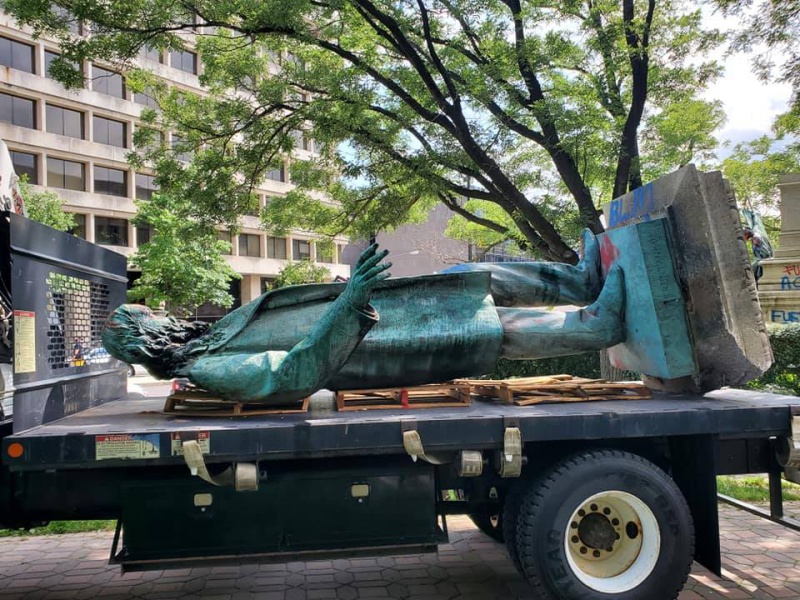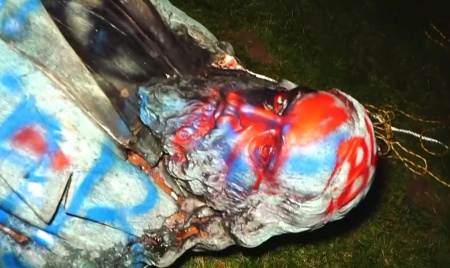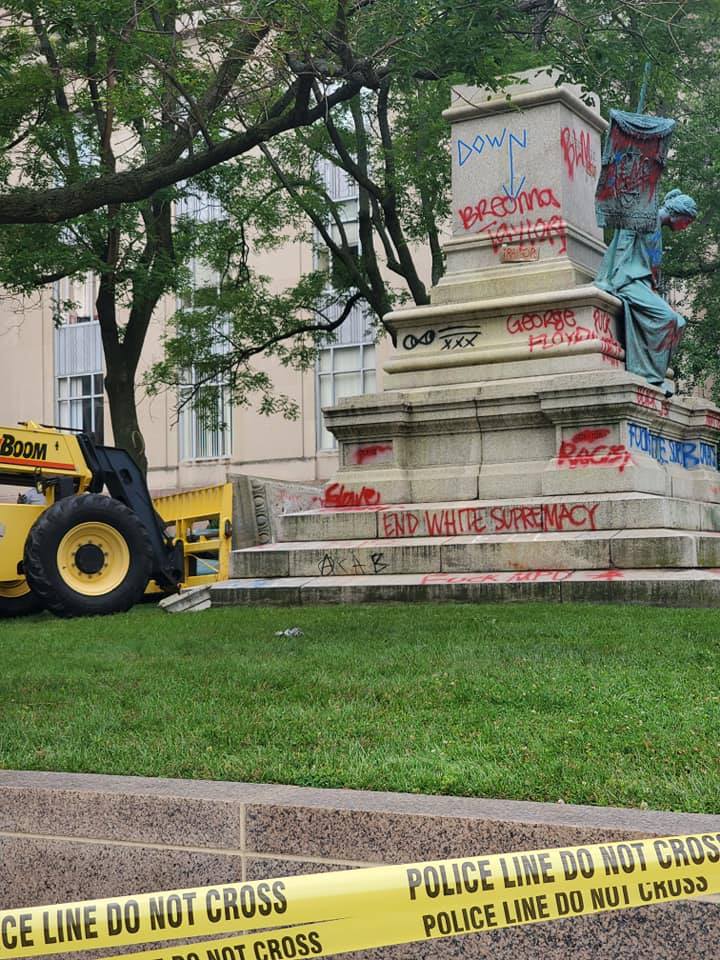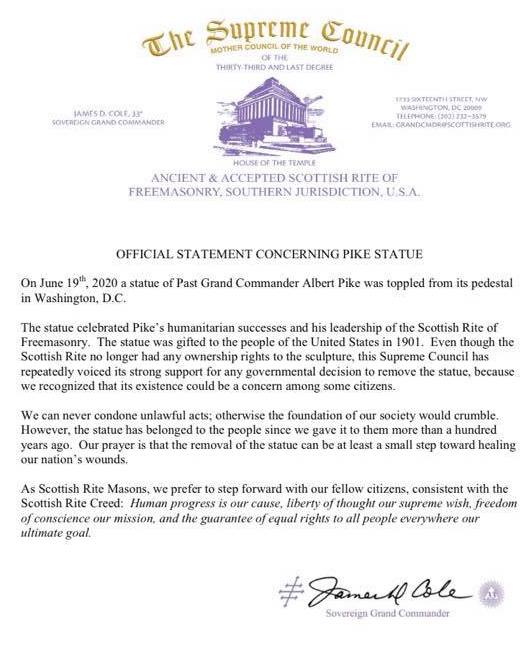En: Albert Pike Statue: After the Fall
Inhaltsverzeichnis
Albert Pike Statue: After the Fall
On Saturday morning, the fallen bronze carcass of Albert Pike's once noble statue in Washington, DC's Judiciary Square was ignominiously hauled away on the back of a flatbed truck to an unspecified location. Pike's figure was toppled and defaced by a mob of protesters late Friday night.
Art De Hoyos was interviewed on the local NBC affiliate in Washington DC on Saturday for his comments on the incident. Unfortunately, little of Art's actual interview actually made it into the segment, which was edited to reinforce the false narrative that this was a 'Confederate monument.' Their 'fact checkers' were in such a hurry to do so that they misspelled Art's name.
To me, that's most frustrating about the incident — the dishonest media coverage and deliberate mischaracterization of Albert Pike and the statue itself. Of course this wasn't a 'Confederate monument.' It was a Masonic representation of Pike's accomplishments as an author, philosopher, orator, lawyer, historian, polyglot, and a soldier (not only in his brief stint in the Confederate army, but also in the Mexican-American War). He wasn't atop a horse; he had no sword dangling from his belt; there was no declaration of heroship, and no phony bromide about 'healing a divided nation' that are the hallmarks of Civil War statues. Pike stood there with a book in his hand and the inscription Vixit Laborum Ejus Super Stites Sunt Fructus. "He has lived. The fruits of his labors live after him." Yet few - if any - who tore it down had any interest in actually looking up what the fruits of his labors actually were.
I find myself in a curious position over ol' Albert. I have never been a staunch fan of Albert Pike's writings. In the very first edition of my book Freemasons For Dummies written in 2004, I wrote about him because he was such a dominating influence on a large part of the fraternity, and because he was such a lightening rod for conspiracy theories. Albert Pike never had an unexpressed thought in his entire life — he wrote thousands of pages of books, letters, articles, rituals, and more, on top of his legal career, newspaper editorship, translations of foreign and ancient texts, and his role on the Arkansas Supreme Court before the war. Just by committing so many words to paper across his 82 years on Earth, that alone left an enormous pile of material that permits conspiracists to claim literally anything about him. And they have.
I had been a Mason for barely six years at the time I was writing, and I was not (and am not today) a member of the Ancient Accepted Scottish Rite - Southern Jurisdiction. In the NMJ, we read and know almost nothing about Pike, nor did we adopt his rituals. The Northern and Southern Jurisdictions have almost nothing in common, ritualistically. Those of us in the fifteen northeastern states of the AASR-NMJ have never been handed copies of his masterwork, Morals & Dogma (as opposed to ALL Southern Jurisdiction members until the 1970s). So we have never particularly revered him or even studied his work, unless it is done independently by individuals. Until the advent of the easy circulation of information wrought by the Internet, quite literally half of the Masonic population of the United States and an enormous part of it outside of the U.S. would hear the name of Albert Pike and tell you, "Never heard of him." And they weren't lying.
In a sidebar section of my book called 'Mysticism, magic, and Masonic mumbo-jumbo,' I was speaking about a group of intellectual 19th century Masons who chose to believe that Masonry had far more mystical and esoteric origins than it likely had. I put Pike in that group of writers who had "dazzling intellectual and spiritual knowledge."
"The works of these men were filled with fabulous tales of beliefs and cultures and cryptic theories of the deepest and earliest origins of Freemasonry," I confidently wrote.
"In short," I said, "they wrote a lot of crap."
Let's just say that in 2004, I had a less than serviceable appreciation of Pike's true scholarship. Since that time, I revised that passage of the book and removed that offhanded and ill-chosen dismissal of Pike and writings. Nevertheless, I find myself in the bizarre position today of pleading his case posthumously to an uncaring and prejudicial mob of press, civic officials, destructive protesters, and casual observers who have an even more superficial comprehension of Pike than I did 16 years ago.
There's no way of knowing how many people encountered the Pike statue over the last 119 years and said "Who the hell was this guy?" and actually tried to find out. But that is always the lingering hope when civic leaders erect statues to former icons - that future generations will try to discover why that person was considered honorable or admirable or heroic enough to be cast in bronze for the Ages.
Apologists for the mob's destruction claim Pike's bronze figure's very existence caused 'pain,' but not because of anything actually on the statue itself. It could only cause distress if a person believed the lopsided message that Pike's brief time in the Confederate army was the defining aspect of his life (which it certainly was not). Or the completely unproven allegation that he had anything whatsoever to do with the Ku Klux Klan (which he disparaged). Or that he was an ardent proponent of slavery (he was not, and wrote against it on numerous occasions). Or that he was a bigoted racist who really hated people of color (he lived among the Indians, defended their rights and interests to the U.S, Supreme Court, learned numerous languages, studied and admired numerous non-Western cultures, religions and peoples, and assisted the Prince Hall-descended Scottish Rite by becoming friends with its African-American Commander and giving them copies of his revised ritual).* Scraping Pike's image from the face of the Earth doesn't change a single person's life, save a life, sustain a life, or improve anyone's life in any way.
Yet, passing by or reading about Pike's statue and making a note to follow up and see WHY he was revered can, and has, changed lives of men who joined the Masons because they were intrigued by Morals & Dogma or Esoterika or other writings of Pike's they stumbled into by accident. No real way of knowing how many, but I'll bet a functioning kidney that far more were influenced positively by it than those who truly were genuinely emotionally distraught over its existence.
And now, that influence no longer going to be possible.
As society changes, so do the people we admire and honor as a combined culture. I occasionally ponder who the current society we have really admires now by general agreement and acclimation. We don't erect many statues anymore in the West, not because they have fallen out of favor, but because we as a society no longer agree on admiring ANYONE anymore, unless it's a sports figure or some anonymous 'Everyman' sort of generic representation of the common man. Politicians, explorers, writers, artists, musicians, inventors, theologians, philosophers, military figures – all those areas of achievement used to be celebrated and honored, and sometimes even rose to the stature of 'heroic.' But we've become so used to tribalizing, trivializing, snarking, digging for dirt, picking at scabs, and otherwise seeking the tarnish on every person who rises to prominence because they don't fulfill some impossible level of perfection and purity. Miserablism as a teaching method has triumphed, and we have become incapable of discovering individual heroes worthy of memorializing For the Ages anymore. The best we can seem to work up in 2020 is a participation trophy-style of group heroism and admiration, like 'our first-responder heroes,' our 'medical personnel heroes,' our 'brave restaurant workers.' One idly wonders if 50 years from now anyone will propose a Washington DC memorial installation to their memories.
I wonder what Joseph Campbell would make of us all right now, knowing that humans have always craved the lone figure of 'The Hero' for inspiration and emulation, and seeing that Western society is incapable of it anymore.
In February 1993, the Philalethes magazine published a piece about the Pike statue controversy that was raging back then. It was written by the Reverend Howard L. Woods, a Christian minister who served for ten years as the Grand Master of the Most Worshipful Prince Hall Grand Lodge of Arkansas F&AM. In 1991, he had been invited as the Lecturer for the Philalethes Society, the first Prince Hall Mason ever asked to do so, and still many years before Prince Hall recognition became widespread. GM Woods wrote before more recent scholarship has brought to light more of Pike's writings and verification that Pike did indeed provide his revised Scottish Rite rituals to help the Prince Hall aligned Scottish Rite.
The reverend Grand Master Woods' perspective in 1993 deserves to be repeated now, in light of what has happened this weekend.
The Albert Pike Statue: Let It Stand There is no love lost between Prince Hall Masons and the memory of the late Albert Pike, Masonic Historian, writer, alleged ritualist for the Ku Klux Klan, but, if Freemasonry is to remain the bulwark of free-thinking people, then, "Let the statue remain!" Like the natures he wrote about, Albert Pike showed the light and dark sides of his own soul, when with one breath he spoke of his willingness to give up his Freemasonry rather than recognize the Negro as a 'Masonic Brother' and with another breath, declared that every man should be free, for a free man is an asset, while a slave is a liability. Mankind is that way, and as long as the statue stands, America and Freemasonry will survive. Let the statue be torn down and America and Freemasonry will be in jeopardy, for one would have to wonder, "What would be next?" As a Prince Hall Mason, an African American and supposedly free-thinker, I can see a higher power than the mortal mind of Albert Pike guiding his pen as he wrote such beautiful words of life without an occasional helping hand from someone "bigger than you or I." Let the statue stand, even if it is proven that Albert Pike did write ritual for the Ku Klux Klan; more ignoble deeds have been done by others without sacrifice of their historic heroism. Let the statue stand as a reminder that the good and evil of men are in equilibrium within us, and we all should strive for perfection now and in the future, not in the past. Let the statue stand!
--Rev. Howard L. Woods, Grand Master, Prince Hall Masons of Arkansas.
- NOTE: Between 1887 and 1891, Albert Pike happily shared personal, autographed copies of his Scottish Rite Masonic degree rituals with his counterpart, Thornton A. Jackson, in the parallel Scottish Rite Southern Jurisdiction for black Prince Hall Masons, in order to assist their fledgling organization. Pike's correspondence has not survived, but in writings of the period, Jackson described Pike as his friend. Later comparisons of their two sets of rituals confirmed that the Prince Hall AASR-SJ today remain very close to those Pike wrote in the years before 1887.
Photos by Brother Efrian Olujimi Dalle; H/T to Brother Michael Wright
Grand Master's Statement
My Brethren,
This communication is directed to the Freemasons in the Grand Lodge, F.A.A.M of Washington, DC.
Most of you know of the recent destruction of the statue of Albert Pike in our Nation’s Capital. Regardless of your personal opinions about Albert Pike, I hope we can all agree as Masons that mob violence is not the way to resolve differences of opinion. The statue, which belongs to the U.S. National Park Service, was erected by an Act of Congress in 1898 and has been controversial from the beginning. Since its placement, neither the Scottish Rite nor our Grand Lodge has had ownership, responsibility, or control over the maintenance or fate of the statue.
To ignore the many positive contributions that Albert Pike made to Freemasonry later in his life, or to ignore the several controversial issues that his biography raises, would be equally disingenuous and dishonest. None of us are perfect human beings. Were we each to be judged solely by our bad decisions, rather than the totality of our life’s work, there would be very few statues indeed.
Those who vandalized the Pike statue are entitled to receive that same consideration. I hope you will choose to focus on the values of redemption, forgiveness, and love when forming your perspectives of this incident – towards both factions. Our task as Freemasons is to build bridges of communication and understanding. By looking forward instead of backward, we make progress in improving ourselves and our nation as we strive to build a more perfect Union.
The main purpose of this message is to address the here and now. What happened last Friday night is neither the beginning nor the end of these struggles toward the realization of the more egalitarian and representative society that our ritual teaches. And many of you are rightly passionate about these issues.
As we engage as members and leaders of our communities, I ask you to remember some of our core lessons, where we are instructed to “keep our passions within due bounds.” The ‘secrets’ of Freemasonry are not about some hidden treasure, but about how to control ourselves. It is a daunting challenge. Today’s abundance of social media outlets offers each of us almost countless opportunities to stress the limits of that control.
For your consideration I offer here the “Conclusion” of our Grand Lodge Social Media Policy, available on our website:
"Posting a comment related to the Fraternity and then posting a disparaging comment about a social or political stance can easily mislead a reader to believe your stance is representative of Masonry and all Masons. Remember that the public and members of the Masonic Fraternity are reading your posts online. You should always maintain your online conduct in a manner that elevates non-Masons’ image of the Craft and of your own dedication to it, and avoids any implication of improper or un-Masonic behavior as defined in the Code of our Grand Lodge."
Brethren, I ask you to heed this advice. Help to lower the temperature, not raise it. Be extremely conscious of the choices you make. And when you choose to comment on social media or provide remarks to the press, be aware that you speak as an individual. You are certainly – and hopefully – informed by your Masonic knowledge, but you do not speak for our Grand Lodge, nor Freemasonry in general. There is only one voice temporarily burdened with that responsibility.
In the absence of a clearly evident rationale for it, we must control our ego and avoid associating ourselves with our Craft in social postings. Let us be particularly vigilant to avoid using our wonderful but confusing honorific titles that cause further consternation among non-Masons.
Brethren, be part of the solution and do not exacerbate the problems. Together we can take up the challenge to circumvent divisiveness and act to help heal our Nation.
I want all of you to know that the leadership of your Grand Lodge is very much aware of the situation, and we are constantly looking to foster and promote the concepts of Freemasonry in our wonderful city of Washington, DC.
Thank you. May the Grand Architect continue to bless your families and your endeavors.
Sincerely & Fraternally,
Michael D. Nicholas, Sr.
Grand Master
The Grand Lodge, FAAM of Washington, DC
Grand Commander James Cole of the Supreme Council of the Scottish Rite Southern Jurisdiction
And the following statement was issued by the Grand Commander James Cole of the Supreme Council of the Scottish Rite Southern Jurisdiction :
Official Statement Concerning Pike Statue
On June 19th, 2020 a statue of Past Grand Commander Albert Pike was toppled from its pedestal in Washington, D.C.
The statue celebrated Pike’s humanitarian successes and his leadership of the Scottish Rite of Freemasonry. The statue was gifted to the people of the United States in 1901. Even though the Scottish Rite no longer had any ownership rights to the sculpture, this Supreme Council has repeatedly voiced its strong support for any governmental decision to remove the statue, because we recognized that its existence could be a concern among some citizens.
We can never condone unlawful acts; otherwise the foundation of our society would crumble. However, the statue has belonged to the people since we gave it to them more than a hundred years ago. Our prayer is that the removal of the statue can be at least a small step toward healing our nation’s wounds.
As Scottish Rite Masons, we prefer to step forward with our fellow citizens, consistent with the Scottish Rite Creed: Human progress is our cause, liberty of thought our supreme wish, freedom of conscience our mission, and the guarantee of equal rights to all people everywhere our ultimate goal.
James D. Cole, 33° Sovereign Grand Commander Monday, June 22, 2020





